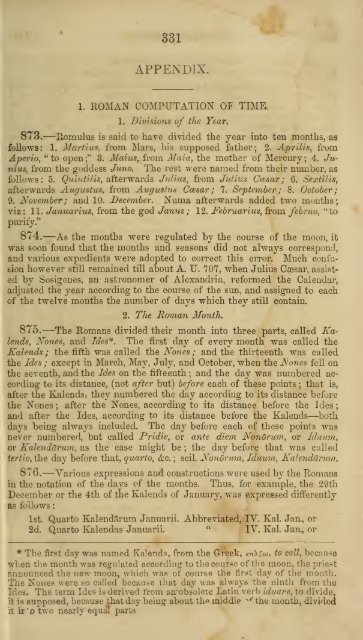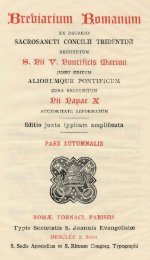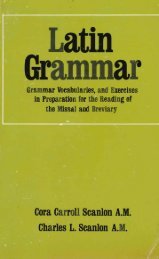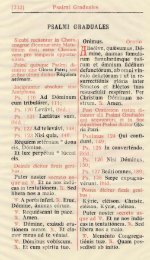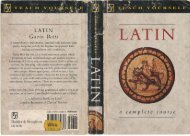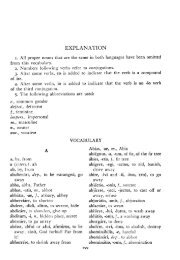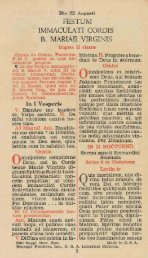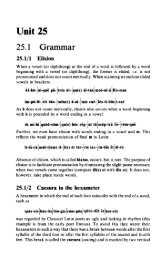The principles of Latin grammar; comprising the ... - Essan.org
The principles of Latin grammar; comprising the ... - Essan.org
The principles of Latin grammar; comprising the ... - Essan.org
- No tags were found...
You also want an ePaper? Increase the reach of your titles
YUMPU automatically turns print PDFs into web optimized ePapers that Google loves.
:;331APPENDIX.1. ROMAN COMPUTATION OF TIME.1. Divisions <strong>of</strong> <strong>the</strong> Year.873.—Romulus is said to have divided <strong>the</strong> year into teu months, asfollows; 1. Martins, from Mars, his supposed fa<strong>the</strong>r; 2. Aprilis, fromAperio, "to open;" 3. Maius, from Mai a, <strong>the</strong> mo<strong>the</strong>r <strong>of</strong> Mercury; 4. Junius,from <strong>the</strong> goddess Juno. <strong>The</strong> rest were named from <strong>the</strong>ir number, asfollows: 5. Quintilis, afterwards Julius, from Julius Ccesar ; 6. Sextilis,afterwards Augustus, from Augustus Ccesar; 7. September ; 8. October;9. November; and 10. December. Nunia afterwards added two mouths;viz : 11. Januarius, from <strong>the</strong> god Janus ; 12. Februarius, from februo, u topurify."874.—As <strong>the</strong> months were regulated by <strong>the</strong> course <strong>of</strong> <strong>the</strong> moon, itwas soon found that <strong>the</strong> months and seasons did not always correspond,and various expedients were adopted to correct this error. Much confusionhowever still remained till about A. U. 707, when Julius Caesar, assistedby Sosigenes, an astronomer <strong>of</strong> Alexandria, reformed <strong>the</strong> Calendar,adjusted <strong>the</strong> year according to <strong>the</strong> course <strong>of</strong> <strong>the</strong> sun, and assigned to each<strong>of</strong> <strong>the</strong> twelve months <strong>the</strong> number <strong>of</strong> days which <strong>the</strong>y still contain.2. <strong>The</strong> Roman Month.875.—<strong>The</strong> Romans divided <strong>the</strong>ir month into three parts, called Kalends,Nones, and Ides*. <strong>The</strong> first day <strong>of</strong> every month was called <strong>the</strong>Kalends; <strong>the</strong> fifth was called <strong>the</strong> Nones; and <strong>the</strong> thirteenth was en lied<strong>the</strong> Ides ; except in March, May, July, and October, when <strong>the</strong> Nones fell on<strong>the</strong> seventh, and <strong>the</strong> Ides on <strong>the</strong> fifteenth ; and <strong>the</strong> day was numbered accordingto its distance, (not after but) before eacli <strong>of</strong> <strong>the</strong>se points ; that is,after <strong>the</strong> Kalends, <strong>the</strong>y numbered <strong>the</strong> day according to its distance before<strong>the</strong> Nones ; after <strong>the</strong> Nones, according to its distance before <strong>the</strong> Idesand after <strong>the</strong> Ides, according to its distance before <strong>the</strong> Kalends—bothdays being always included. <strong>The</strong> day before each <strong>of</strong> <strong>the</strong>se points wasnever numbered, but called Pridie, or ante diem Nonorum, or Iduum,or Kalendarum. as <strong>the</strong> case might be; <strong>the</strong> day before that was callediertio, <strong>the</strong> day before that, quarto, &c. ; scil. Nonorum, Iduum, Kalendarum.876.—Various expressions and constructions were used by <strong>the</strong> Romansin <strong>the</strong> notation <strong>of</strong> <strong>the</strong> days <strong>of</strong> <strong>the</strong> months. Thus, for example, <strong>the</strong> 29thDecember or <strong>the</strong> 4th <strong>of</strong> <strong>the</strong> Kalends <strong>of</strong> January, was expressed differentlyas follows1st. Quarto Kalendarum Januarii. Abbreviated, IV. Kal. Jan., or"2d. Quarto Kalendas Januarii.IV. Kal. Jan., or* <strong>The</strong> first day was named Kalends, from <strong>the</strong> Greek, *aXr-oj, to call, becausewhen <strong>the</strong> month was regulated according to <strong>the</strong> course <strong>of</strong> <strong>the</strong> moon, <strong>the</strong> priestannounced <strong>the</strong> new moon, which was <strong>of</strong> course <strong>the</strong> first day <strong>of</strong> <strong>the</strong> month.<strong>The</strong> Nones were so called because that day was always <strong>the</strong> ninth from <strong>the</strong>Ides. <strong>The</strong> term Ides is derived from amobsolete <strong>Latin</strong> verb iduare, to divide,it is supposed, because that day being about <strong>the</strong> middle ^<strong>the</strong> month, dividedit ir'o two nearly equal parts


